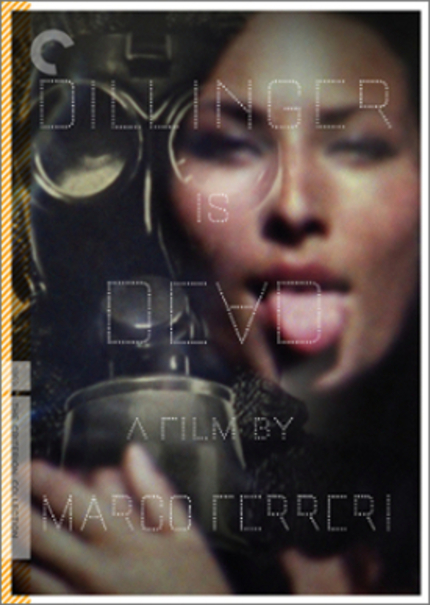Marco Ferreri's DILLINGER IS DEAD DVD Review

Marco Ferreri's 1969 film Dillinger is Dead is now out on DVD
from The Criterion Collection. Ferreri's film is an exercise in pop art
surrealism that captures the aesthetic and political zeitgeist of the
60s. Connoisseurs of avant-garde cinema will be more than pleased with
this release. As for others . . .
Dillinger is Dead depicts a night in the life of an Italian gas mask designer named Glauco (Michel Piccoli). Glauco is tired with his job, his wife (Anita Pallenberg) and the sexy maid (Annie Girardot) with whom he has an affair. He goes through his routine with bored efficiency. While cooking dinner, he discovers a gun wrapped in old newspapers. The lead story in the papers is the shooting of John Dillinger in 1934. He becomes obsessed with Dillinger and the gun. As a result, his mundane existence gives way to escapist fantasies.
Ferreri's film is unorthodox in both style and subject matter. There is no traditional narrative. Events unfold in a seemingly unconnected manner. The film contains very little dialogue. An extended monologue derived from Herbert Marcuse's One-Dimensional Man occurs in the opening scene provides an oblique political framework for understanding what transpires. The ending is most concrete element of the film, but is still open-ended and ambiguous.
Given the film's amorphous form, viewers are mostly left to rely on acting, imagery, and sound to guide them. The glue that holds everything together is Michel Piccoli, who uses his body to express what the film refuses to communicate in words. Marcel Marceau is an obvious reference point for Piccoli's performance. Dillinger is Dead is aurally and visually rich, displaying the influence of 60s pop culture and pop art. Pop songs playing in the background operate as a running commentary on Glauco's mental state. Voices and images emanate from a black and white television. Home movies are projected on a wall. Old news reels of Dillinger are spliced into the film. In a nod to Roy Lichtenstein, Glauco paints his gun with polka dots. This Lichtenstein reference is reinforced by the brief appearance of a reproduction of his famous Time Magazine cover later in the film.
Criterion's restored HD digital transfer of Dillinger is Dead is presented in 1.66:1 aspect ratio. The Dolby Digital mono soundtrack is in the Italian language. English subtitles are provided. The extras are generous, which is wise because this film cries out for more context. Interviews with Michel Piccoli and Italian film historian Adriano Apra, who also appears in the film, are provided. Excerpts from a round table discussion about Ferreri with Bernardo Bertolucci, Francesco Rosi, and Aldo Tassone from an 1997 episode of French television show Le cercle de minuit. A thick booklet with a critical essay and reprints of two interviews with Ferreri.
Dillinger is Dead depicts a night in the life of an Italian gas mask designer named Glauco (Michel Piccoli). Glauco is tired with his job, his wife (Anita Pallenberg) and the sexy maid (Annie Girardot) with whom he has an affair. He goes through his routine with bored efficiency. While cooking dinner, he discovers a gun wrapped in old newspapers. The lead story in the papers is the shooting of John Dillinger in 1934. He becomes obsessed with Dillinger and the gun. As a result, his mundane existence gives way to escapist fantasies.
Ferreri's film is unorthodox in both style and subject matter. There is no traditional narrative. Events unfold in a seemingly unconnected manner. The film contains very little dialogue. An extended monologue derived from Herbert Marcuse's One-Dimensional Man occurs in the opening scene provides an oblique political framework for understanding what transpires. The ending is most concrete element of the film, but is still open-ended and ambiguous.
Given the film's amorphous form, viewers are mostly left to rely on acting, imagery, and sound to guide them. The glue that holds everything together is Michel Piccoli, who uses his body to express what the film refuses to communicate in words. Marcel Marceau is an obvious reference point for Piccoli's performance. Dillinger is Dead is aurally and visually rich, displaying the influence of 60s pop culture and pop art. Pop songs playing in the background operate as a running commentary on Glauco's mental state. Voices and images emanate from a black and white television. Home movies are projected on a wall. Old news reels of Dillinger are spliced into the film. In a nod to Roy Lichtenstein, Glauco paints his gun with polka dots. This Lichtenstein reference is reinforced by the brief appearance of a reproduction of his famous Time Magazine cover later in the film.
Criterion's restored HD digital transfer of Dillinger is Dead is presented in 1.66:1 aspect ratio. The Dolby Digital mono soundtrack is in the Italian language. English subtitles are provided. The extras are generous, which is wise because this film cries out for more context. Interviews with Michel Piccoli and Italian film historian Adriano Apra, who also appears in the film, are provided. Excerpts from a round table discussion about Ferreri with Bernardo Bertolucci, Francesco Rosi, and Aldo Tassone from an 1997 episode of French television show Le cercle de minuit. A thick booklet with a critical essay and reprints of two interviews with Ferreri.
Dillinger Is Dead
Director(s)
- Marco Ferreri
Writer(s)
- Marco Ferreri (story)
- Marco Ferreri (screenplay)
- Sergio Bazzini (screenplay)
Cast
- Michel Piccoli
- Anita Pallenberg
- Gino Lavagetto
- Mario Jannilli

Do you feel this content is inappropriate or infringes upon your rights? Click here to report it, or see our DMCA policy.






